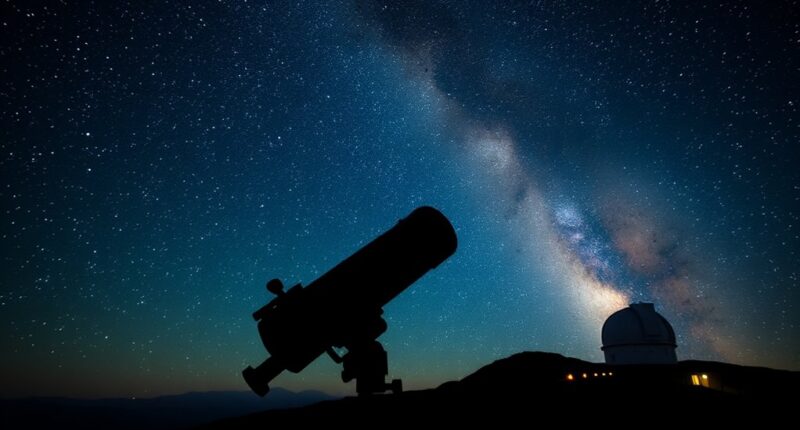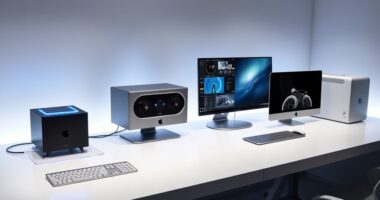If you’re looking to elevate your stargazing, I recommend exploring the top 15 astrophotography telescopes that combine powerful optics, advanced tracking, and user-friendly features. From smart telescopes with dual screens like Dwarf 3 and ZWO Seestar S50 to high-end models like the Celestron NexStar 8SE and 150mm refractors, there’s something for every skill level. Keep in mind factors like aperture, stability, and portability. Continue to discover which telescope truly fits your cosmic ambitions.
Key Takeaways
- Top astrophotography telescopes feature high magnification, large apertures, and advanced sensors for capturing detailed celestial images.
- Many models include integrated or compatible tracking mounts, automation, and app controls for precise star tracking.
- Telescopes with high-quality ED glass, multi-coated lenses, and large apertures deliver bright, crisp, and distortion-free images.
- Portable options with lightweight designs and quick setup are ideal for outdoor astrophotography adventures.
- Advanced models offer 4K imaging, external storage, and dual imaging modes for versatile astrophotography and deep-sky imaging.
Dwarf 3 Smart Telescope
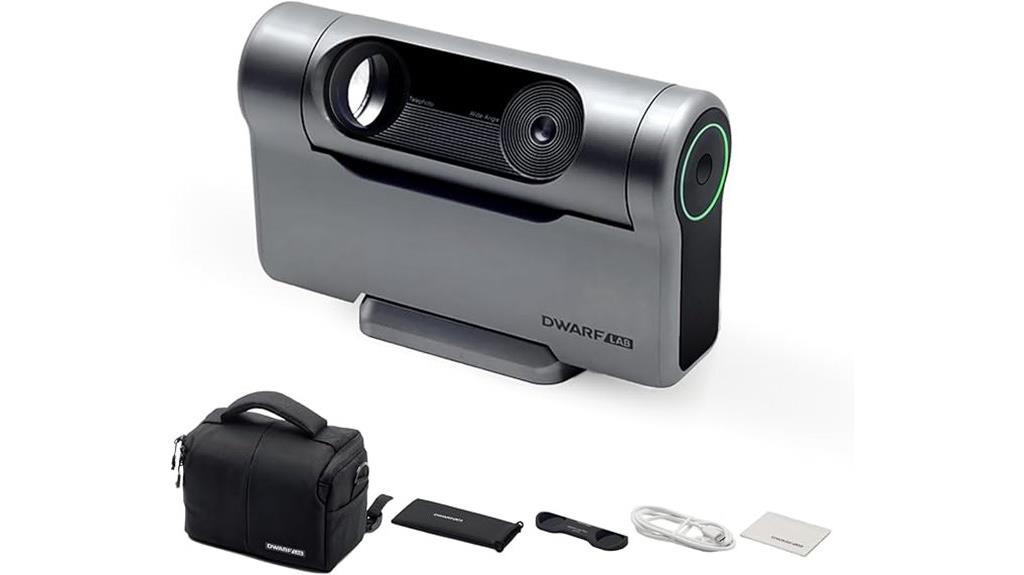
If you’re looking for a highly portable and versatile telescope, the Dwarf 3 Smart Telescope is an ideal choice. Weighing just 3 pounds, it’s incredibly lightweight and fits easily into a backpack, making it perfect for travel and spontaneous outings. Its compact design means you can take it anywhere—whether you’re exploring the night sky or capturing wildlife and landscapes during the day. The dual imaging system allows for both daytime and nighttime photography, with advanced lenses for detailed images. Plus, the smart auto-tracking guarantees clear shots of celestial objects or moving subjects, all enhanced effortlessly through cloud processing.
Best For: outdoor enthusiasts, amateur astronomers, and travelers seeking a portable, versatile telescope for both daytime and nighttime photography.
Pros:
- Ultra-lightweight at only 3 pounds, making it highly portable and easy to carry.
- Dual imaging system with advanced lenses enables high-quality photos of stars, wildlife, and landscapes.
- Smart auto-tracking with cloud processing ensures clear, steady images effortlessly.
Cons:
- May have limited magnification compared to larger, professional telescopes.
- Requires a compatible smartphone or device to operate the DWARFLAB app and cloud features.
- Slight learning curve for beginners unfamiliar with astrophotography or dual-camera systems.
ZWO Seestar S50 Smart Digital Telescope
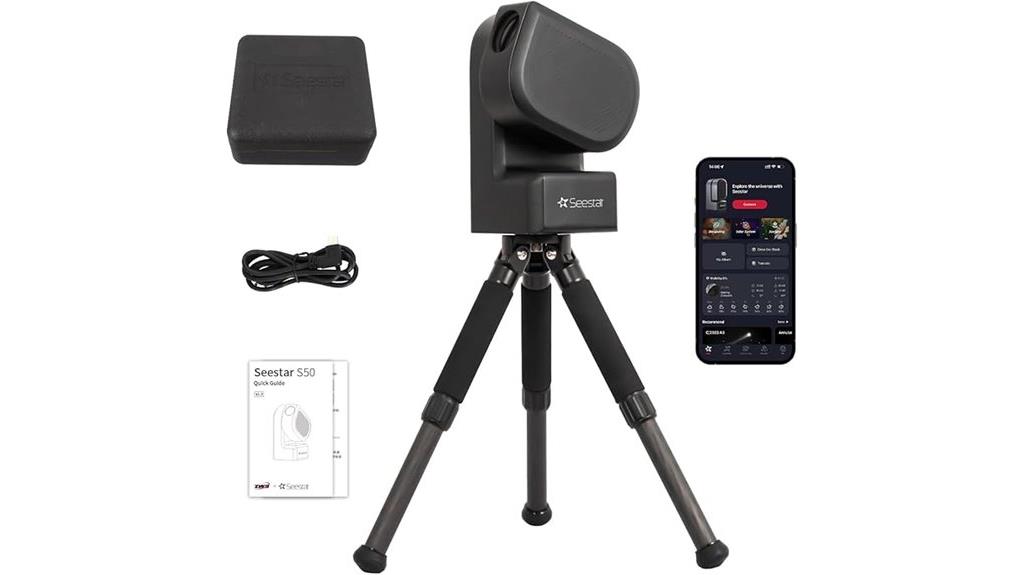
The ZWO Seestar S50 Smart Digital Telescope stands out as an excellent choice for beginners and casual astronomers who want a portable, all-in-one solution. Weighing just 2.5kg, it’s lightweight yet packs a compact design that combines the telescope, electrical focuser, camera, ASIAIR, altazimuth mount, and dew heater. Its professional-grade triplet apochromatic optics deliver crisp, clear images while reducing light loss and chromatic aberration. With smart app integration, you can easily find, track, and target objects using your phone, making setup simple. It’s perfect for those looking to explore the night sky without fuss, whether for casual stargazing or astrophotography.
Best For: casual astronomers, beginners, and educators seeking a portable, all-in-one telescope with smart app features for easy sky exploration.
Pros:
- Lightweight and compact design weighing only 2.5kg for easy portability
- Professional-grade triplet apochromatic optics for sharp, high-quality images
- Fully automated app controls for effortless find, track, and target functions
Cons:
- May have limited advanced features compared to larger, more specialized telescopes
- Integration relies heavily on smartphone app, which could be less ideal for manual operation
- Slightly constrained optical aperture compared to larger telescopes, potentially limiting deep-sky imaging
Smart Telescope with 4K Astrophotography Camera and Dual Screens
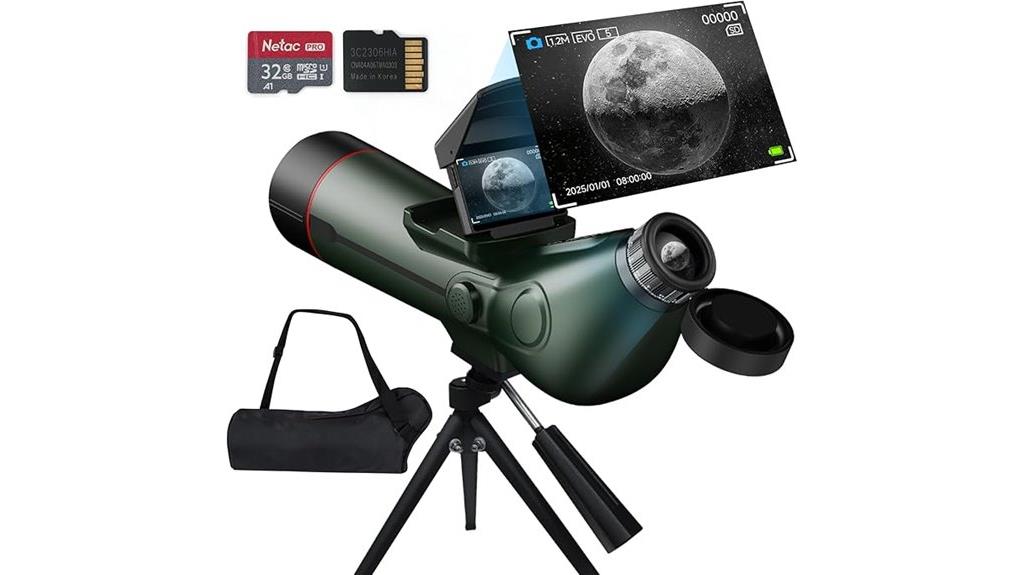
This smart telescope stands out for its 4K astrophotography camera and dual screens, making it ideal for amateur astronomers and nature enthusiasts who want high-quality imaging combined with real-time observation. Its 80mm aperture and 300mm focal length deliver bright, sharp views, supporting up to 350X magnification. The starlight-grade sensor captures stunning 4K images and videos, even in low-light or moonlit conditions. With an adjustable eyepiece, foldable external screen, and internal eyepiece, it offers personalized focus and vivid, live viewing. Its quick photo and video switch, plus support for large external storage, make capturing and sharing celestial moments effortless.
Best For: amateur astronomers, astronomy enthusiasts, and nature lovers seeking high-quality imaging and real-time celestial observation.
Pros:
- Supports up to 350X magnification for detailed long-distance viewing.
- Equipped with a 4K starlight-grade sensor for stunning high-resolution images and videos.
- Dual screens and adjustable eyepiece provide customizable, vivid live observation experiences.
Cons:
- Battery life is limited to around 6 hours, which may require external power for extended sessions.
- The device’s advanced features might have a steep learning curve for complete beginners.
- Relatively compact, portable design may limit some functionalities compared to larger telescopes.
Celestron NexStar 8SE Computerized Telescope

For beginners and experienced astronomers alike, the Celestron NexStar 8SE Computerized Telescope stands out as an excellent choice, thanks to its combination of advanced technology and user-friendly features. Its iconic orange Schmidt-Cassegrain design packs an 8-inch aperture, gathering plenty of light for detailed lunar, planetary, and deep-sky views. The fully computerized GoTo mount and NexStar+ controller access a database of over 40,000 objects, automatically slewing and tracking targets. Setup is quick with SkyAlign technology—just center three bright objects, and you’re ready to observe. Compatible with Celestron accessories and backed by a 2-year warranty, it’s a reliable, portable option for stargazing enthusiasts.
Best For: both beginners and experienced astronomers seeking a portable, easy-to-use telescope with advanced features and high-quality optics.
Pros:
- Combines an 8-inch aperture with Schmidt-Cassegrain optics for clear, detailed views of lunar, planetary, and deep-sky objects.
- Fully computerized GoTo mount with a database of over 40,000 objects for effortless target locating and tracking.
- Quick and simple SkyAlign setup technology makes it ideal for users new to astronomy or those who want fast setup times.
Cons:
- May be heavier and less portable compared to smaller, less powerful telescopes.
- Advanced features and accessories could be overwhelming for complete beginners without prior knowledge.
- The cost might be higher than entry-level telescopes, potentially limiting accessibility for casual stargazers.
Telescope for Adults, 90mm Aperture 800mm Refractor with Tripod & Phone Adapter
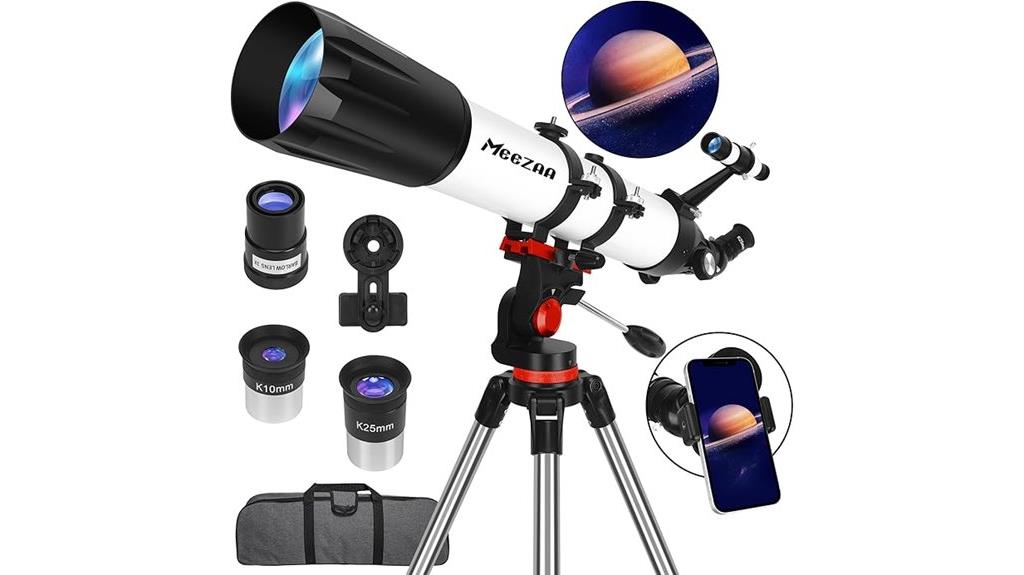
If you’re an adult or beginner looking to explore the night sky without hassle, the 90mm Aperture 800mm Refractor with Tripod & Phone Adapter offers an excellent balance of performance and ease of use. Its 90mm aperture captures more light, delivering brighter, clearer images of the moon, planets, and stars. The fully multi-coated lenses enhance viewing quality, while the adjustable stainless steel tripod ensures stability at various heights. With two eyepieces and a 3X Barlow lens, you can easily switch between magnifications up to 240X. The quick assembly, detailed manual, and included phone adapter make capturing photos straightforward, perfect for backyard astronomy or outdoor adventures.
Best For: adult beginners and outdoor enthusiasts seeking an easy-to-use, portable telescope for exploring the night sky, nature, and celestial objects.
Pros:
- Bright, clear images thanks to 90mm fully multi-coated optical lenses and high light transmission.
- Versatile magnification range up to 240X with included eyepieces and Barlow lens.
- Easy and quick assembly with a detailed manual, suitable for beginners and experienced users.
Cons:
- May require additional accessories for advanced astrophotography beyond basic phone capturing.
- The adjustable tripod, while stable, may not be suitable for extremely rough terrain.
- Limited to terrestrial and basic astronomical viewing; not designed for professional astrophotography or deep-sky imaging.
Telescope 150EQ Newtonian Reflector Telescope for Adults

The Telescope 150EQ Newtonian Reflector is an excellent choice for both amateur astronomers and outdoor enthusiasts seeking high-quality stargazing experiences. Its 150mm aperture and 650mm focal length deliver bright, crisp images of planets, the Moon, and deep-sky objects. With a versatile magnification range from 26X to 130X, it’s perfect for detailed observation. The upgraded German equatorial mount allows smooth manual tracking, while the sturdy stainless steel tripod keeps everything stable. Plus, the all-inclusive accessories, including eyepieces, a moon filter, and a phone adapter, make setup quick and easy—ideal for beginners and seasoned stargazers alike.
Best For: beginner and experienced amateur astronomers, outdoor enthusiasts, and families seeking a high-quality, portable telescope for celestial observation.
Pros:
- Large 150mm aperture delivers bright, clear images of planets, the Moon, and deep-sky objects.
- Upgraded German equatorial mount ensures smooth, precise manual tracking.
- Comes with comprehensive accessories, including eyepieces, moon filter, and phone adapter for versatile viewing.
Cons:
- May be heavier and bulkier compared to smaller, more portable telescopes.
- Requires some initial setup, which might be challenging for absolute beginners without prior experience.
- Optical performance is optimized for amateur use; professional astronomers may seek higher-end equipment.
SVBONY SV503 Refractor Telescope with Built-in Field Flattener

The SVBONY SV503 Refractor Telescope stands out with its built-in field flattener, making it an excellent choice for astrophotographers who demand sharp, distortion-free images across the entire field of view. Its 70mm aperture and F/6.78 focal ratio produce bright, detailed images of galaxies, nebulae, and star clusters. Thanks to ED glass, it reduces chromatic aberration, ensuring true colors and crisp clarity. The self-flat-field design means no extra accessories are needed for ideal images. With a dual-speed focuser and durable CNC components, it offers precise focus and stability. Overall, it’s a versatile, reliable telescope perfect for both beginners and seasoned astrophotographers.
Best For: amateur and experienced astrophotographers seeking a high-quality, distortion-free refractor telescope with minimal setup and excellent image clarity.
Pros:
- Built-in field flattener provides wide, flat, distortion-free views without extra accessories
- ED glass reduces chromatic aberration, ensuring true-to-life colors and sharp images
- Durable CNC construction and stable mounting system enhance reliability and imaging stability
Cons:
- Limited aperture size may restrict deep-sky object brightness for some users
- Focal ratio of F/6.78 might require longer exposure times for astrophotography
- Suitable mainly for terrestrial and celestial viewing, not ideal for large aperture deep-sky imaging
Gskyer 130EQ Professional Reflector Telescope
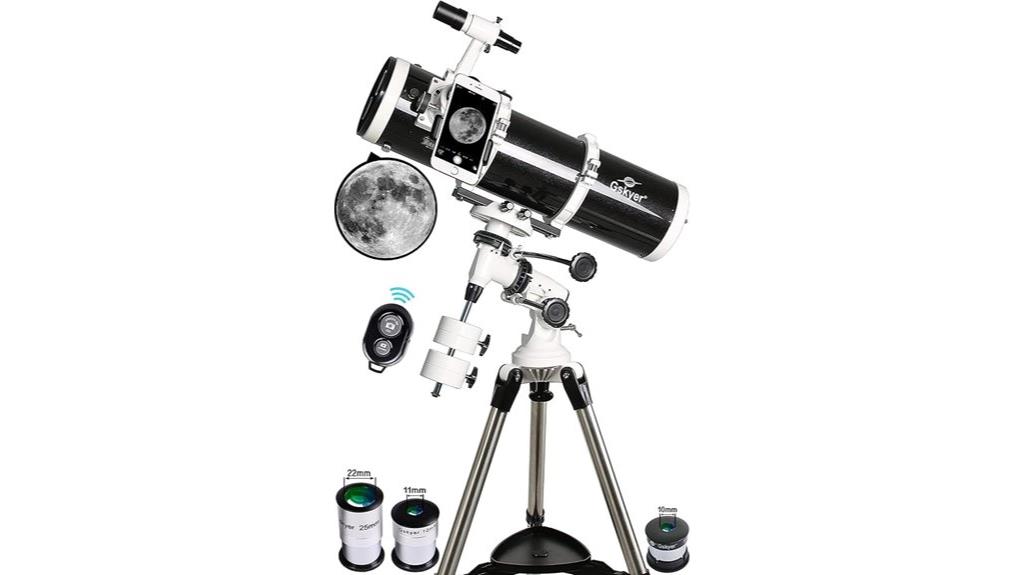
Designed for both beginners and experienced astronomers, the Gskyer 130EQ Professional Reflector Telescope stands out with its impressive 5.1-inch aperture and all-glass optical components, ensuring bright, clear images of the Moon, planets, and deep-sky objects. Its compact 24-inch optical tube and fast f/5 focal ratio make setup quick and observation straightforward. The telescope’s toothless focusing base offers smooth, precise adjustments, while included accessories like three eyepieces, a 3X Barlow lens, and a finderscope enhance viewing versatility. Plus, the Bluetooth remote control lets you capture images or videos easily, making stargazing more engaging and accessible.
Best For: beginner and experienced astronomers seeking a versatile, easy-to-use reflector telescope with high-quality optics and modern connectivity features.
Pros:
- Bright, clear images of the Moon, planets, and deep-sky objects thanks to the 5.1-inch aperture and all-glass optical components.
- User-friendly focusing mechanism with a toothless base for precise adjustments and quick setup.
- Bluetooth remote control allows for easy photo and video capturing directly from smartphones without app downloads.
Cons:
- Limited to visual observation and basic imaging; not suitable for advanced astrophotography.
- The 24-inch optical tube may require a sturdy setup to prevent vibrations during viewing.
- May be less portable for travel compared to smaller, compact telescopes.
Celestron StarSense Explorer DX 130AZ Telescope with Smartphone Dock
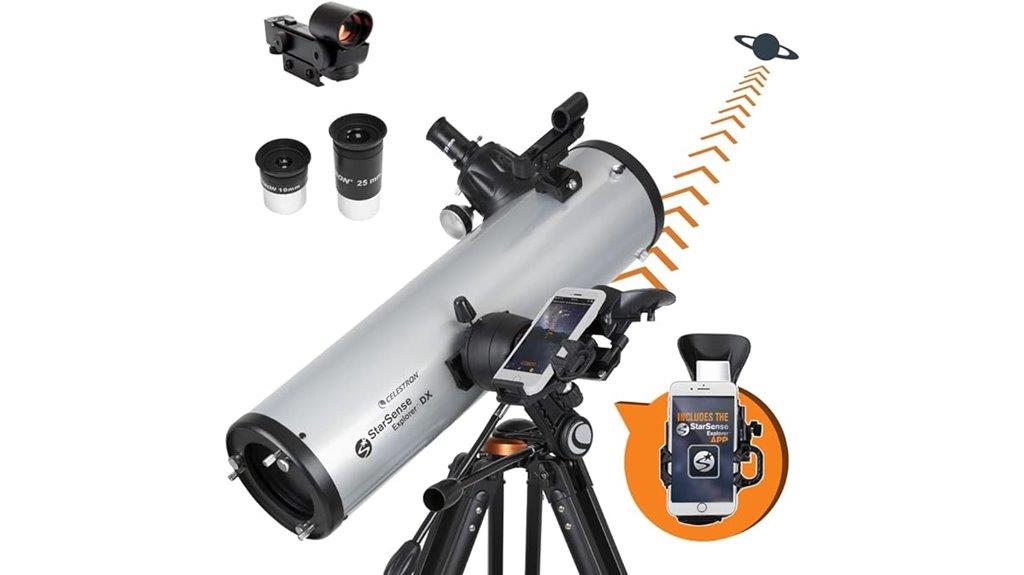
If you’re a beginner looking for an easy-to-use astrophotography telescope, the Celestron StarSense Explorer DX 130AZ stands out with its smartphone docking and app-guided navigation. Its 130mm Newtonian reflector provides bright, sharp views of the Moon, planets, and deep-sky objects like the Orion Nebula and Andromeda Galaxy. The manual altazimuth mount with dual-axis slow-motion controls makes setup simple and smooth tracking effortless. The patented StarSense technology analyzes star patterns to pinpoint objects, guiding you via the app’s on-screen arrows. With straightforward assembly, no prior experience is needed, and the 2-year warranty guarantees reliable support from Celestron’s US-based team.
Best For: beginners and amateur astronomers seeking an easy-to-use, app-guided telescope for exploring the night sky with smartphone integration.
Pros:
- Smartphone docking with app-guided navigation simplifies star-hunting for novices
- Bright 130mm aperture provides crisp views of the Moon, planets, and deep-sky objects
- Manual altazimuth mount with slow-motion controls offers smooth tracking and easy setup
Cons:
- Limited to manual tracking; not suitable for advanced astrophotography
- Newtonian reflector design requires occasional collimation for optimal image quality
- App reliance means performance may vary with device compatibility or software updates
Gskyer 70mm Aperture 400mm AZ Refracting Telescope

For beginners and young astronomy enthusiasts, the Gskyer 70mm Aperture 400mm AZ Refracting Telescope offers an excellent balance of simplicity and performance. Its 70mm aperture and 400mm focal length deliver sharp, clear images of the moon and planets, perfect for exploring the night sky. The fully coated optics glass lens enhances light transmission, protecting your eyes while providing stunning views. It comes with two eyepieces, a 3x Barlow lens, and a 5×24 finder scope, making object location easy. Its adjustable tripod, portable carry bag, and smartphone adapter make it ideal for travel and beginner astronomy, ensuring you get started with confidence.
Best For: Beginners, kids, and outdoor enthusiasts interested in exploring the night sky with a portable, easy-to-use telescope.
Pros:
- Bright, sharp images with fully coated optics glass lens for clear viewing.
- Comes with multiple eyepieces, a Barlow lens, and a finder scope for easy object location.
- Compact, lightweight design with a carry bag and smartphone adapter, ideal for travel and outdoor activities.
Cons:
- 70mm aperture may have limitations for deep-sky object viewing compared to larger telescopes.
- Requires manual adjustment and setup, which might be challenging for very young children.
- Basic tripod might not offer the most stable platform for high-magnification viewing.
Celestron NexStar 130SLT Computerized Telescope
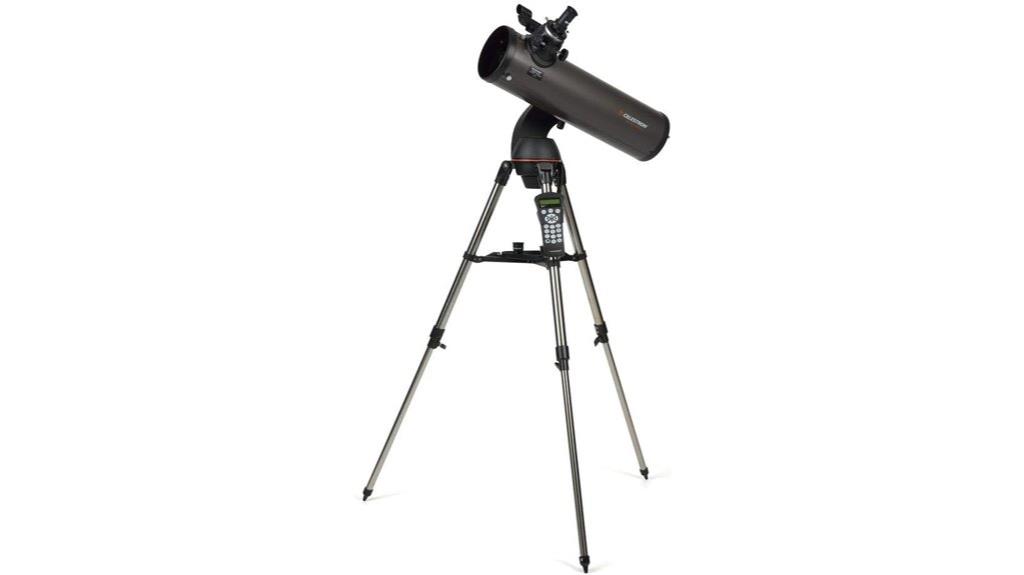
The Celestron NexStar 130SLT Computerized Telescope stands out as an excellent choice for amateur astronomers and hobbyists seeking a portable yet powerful instrument. Its compact Newtonian reflector design features a 130mm aperture, offering bright, detailed views of planets, the Moon, and deep-sky objects. With a database of over 4,000 celestial targets and SkyAlign technology, it’s easy to locate and track objects accurately. Its compatibility with 2-inch eyepieces provides versatile viewing options. Perfect for camping or dark sky trips, it’s backed by a two-year warranty and expert support, making it a reliable, user-friendly option for stargazing enthusiasts.
Best For: amateur astronomers and hobbyists seeking a portable, powerful telescope for viewing planets, the Moon, and deep-sky objects during camping or dark sky trips.
Pros:
- Compact and portable design ideal for travel and outdoor adventures
- Large 130mm aperture provides bright, detailed images of celestial objects
- User-friendly SkyAlign technology simplifies setup and object locating
Cons:
- Newtonian reflector design requires occasional collimation for optimal performance
- Might have a learning curve for complete beginners unfamiliar with star alignment
- Limited to a maximum compatibility with 2-inch eyepieces without additional adapters
ZWO Seestar S30 Smart Digital Telescope/Camera

Weighing only 3.6 pounds, the ZWO Seestar S30 Smart Digital Telescope/Camera is perfect for anyone who values portability without sacrificing functionality. Its lightweight design makes it easy to carry anywhere, whether you’re traveling or exploring outdoors. The integrated Seestar App simplifies operation with automatic star-finding, precise tracking, and one-tap shooting, making astrophotography accessible for beginners and casual stargazers. Equipped with dual lenses—telephoto for distant objects and wide-angle for landscapes—it supports multiple shooting modes, including deep-sky, terrestrial, and solar system imaging. Advanced filters and smart noise reduction guarantee high-quality images in various lighting conditions, elevating your stargazing experience.
Best For: casual stargazers, travel enthusiasts, and beginners seeking an easy-to-use, portable astrophotography solution.
Pros:
- Extremely lightweight at only 3.6 pounds, making it highly portable for outdoor adventures.
- User-friendly Seestar App with automatic star-finding, precise tracking, and one-tap shooting simplifies astrophotography.
- Versatile with dual lenses and multiple shooting modes—deep sky, terrestrial, and solar system imaging—catering to various interests.
Cons:
- Limited to 3.6 pounds, which may affect stability for detailed long-exposure astrophotography.
- Might lack advanced manual controls preferred by experienced astronomers.
- Dependence on the app for operation could be challenging in areas with poor internet or device compatibility issues.
SVBONY SV503 Refractor Telescope, 102mm F7 Achromatic Refractor

If you’re seeking a versatile telescope that excels in both planetary observation and deep-sky astrophotography, the SVBONY SV503 Refractor stands out with its 102mm aperture and F/7 ratio. Its achromatic design uses S-FPL51 ED glass to minimize chromatic aberration, delivering sharp, colorful images. Fully multi-coated optics maximize light transmission, enhancing brightness and contrast. The 90mm back focus allows flexible accessory use, while the dual-speed focuser ensures precise adjustments. The 360° Field Rotator makes framing easy without moving the entire telescope. With a retractable lens hood and included accessories, it’s a reliable choice for serious stargazers and astrophotographers alike.
Best For: amateur astronomers and astrophotographers seeking a versatile, high-quality refractor for planetary and deep-sky observation.
Pros:
- Excellent chromatic aberration correction with S-FPL51 ED glass for sharp, colorful images
- Fully multi-coated optics maximize light transmission and contrast for bright, detailed views
- 360° Field Rotator and dual-speed focuser provide precise framing and focus adjustments
Cons:
- Slightly heavier and bulkier due to 102mm aperture and sturdy construction
- May require additional accessories for advanced astrophotography setups
- Price could be higher compared to entry-level refractors with similar specifications
Celestron StarSense Explorer LT 114AZ Telescope with Smartphone Dock
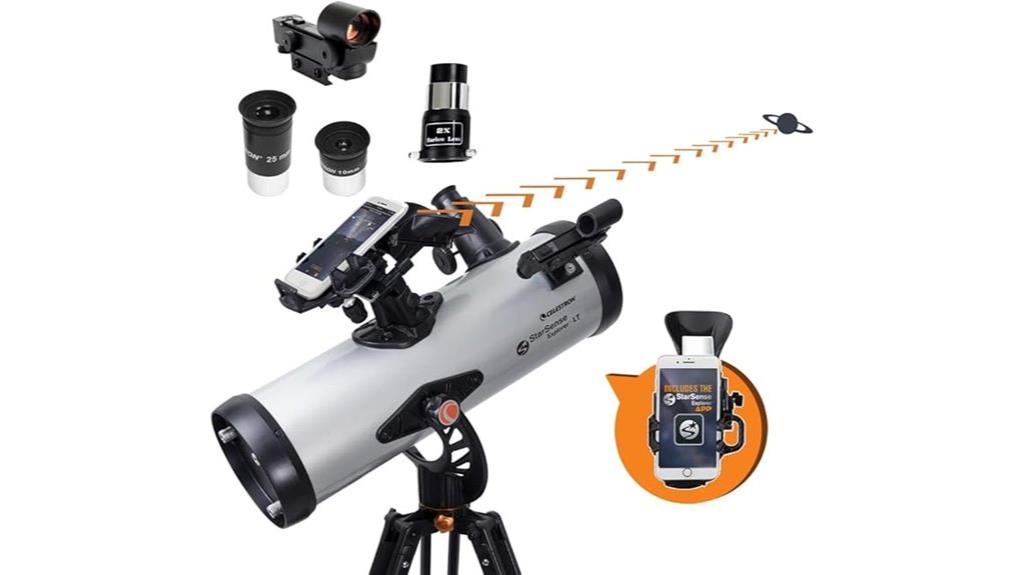
For beginners enthusiastic to explore the night sky without prior experience, the Celestron StarSense Explorer LT 114AZ stands out thanks to its innovative smartphone dock and sky recognition technology. This 114mm Newtonian reflector offers bright, sharp views of the Moon, planets, and deep-sky objects. Its easy-to-use manual altazimuth mount with slow motion controls makes setup simple and tracking smooth. The StarSense technology analyzes star patterns, guiding you to objects via the app on your phone. Just dock your device, follow the on-screen prompts, and enjoy hassle-free astronomy. It’s perfect for newcomers wanting an accessible yet powerful way to start their celestial journey.
Best For: beginners and amateur astronomers seeking an easy-to-use, app-guided telescope for exploring the night sky.
Pros:
- User-friendly smartphone integration with sky recognition technology for effortless object locating
- Bright, sharp images of the Moon, planets, and deep-sky objects thanks to high-quality 114mm reflector optics
- Manual altazimuth mount with slow motion controls allows smooth, precise adjustments during observations
Cons:
- Limited to manual operation without automated tracking features
- May require a compatible smartphone with sufficient battery life for extended sessions
- Not suitable for advanced astrophotography or deep-sky imaging due to its beginner-oriented design
Telescope for Adults, 90mm Aperture 600mm Refractor with Phone Adapter and Tripod

The Telescope for Adults, 90mm Aperture 600mm Refractor with Phone Adapter and Tripod stands out as an excellent choice for beginner astronomers and outdoor enthusiasts who want a versatile and easy-to-use device. Its large 90mm aperture captures more light, delivering bright, clear images of the moon, planets, and stars. The fully coated optics glass lens enhances light transmittance and detail. With adjustable aluminum tripod, multiple magnifications, and a phone adapter, it’s perfect for casual stargazing and astrophotography. Plus, its portability, simple assembly, and included backpack make it convenient for outdoor adventures and family exploration.
Best For: beginner astronomy enthusiasts, families, and outdoor explorers seeking an easy-to-use, portable telescope for celestial observation and astrophotography.
Pros:
- Large 90mm aperture captures more light for bright, detailed images of the moon and planets
- Adjustable tripod with multiple angles allows precise tracking and easy setup
- Includes phone adapter and backpack, enhancing portability and outdoor usability
Cons:
- May require some initial assembly and adjustment for optimal use
- Limited to a maximum magnification of 180x, which might not suit advanced astronomers
- Optical quality is suitable for beginners but may not meet professional research standards
Factors to Consider When Choosing Astrophotography Telescopes

When choosing an astrophotography telescope, I always consider optical quality and aperture because they directly impact image clarity. I also look at the mounting and stability to guarantee steady shots, along with portability for convenience. Finally, I focus on features like camera compatibility and ease of use to match my skill level and shooting goals.
Optical Quality and Aperture
Choosing the right astrophotography telescope hinges heavily on optical quality and aperture size. A larger aperture lets in more light, making your images brighter and revealing finer details of celestial objects. Optical quality depends on the precision of the lens or mirror surfaces; high-quality optics minimize distortions and aberrations, ensuring sharp, clear images. Triplet apochromatic lenses excel at reducing chromatic aberration, resulting in sharper, more color-accurate photos, while achromatic refractors are more budget-friendly but may produce slight color fringing. Additionally, optical coatings on lenses and mirrors boost light transmission and cut reflections, enhancing contrast and clarity. Focusing on these factors helps you capture stunning astrophotos with rich detail and vibrant colors, elevating your stargazing experience.
Mounting and Stability
A stable mount is essential for capturing sharp astrophotos, especially during long exposures, because even slight vibrations can blur images. A solid tripod with lockable, adjustable legs provides a firm foundation, reducing unwanted movements. Equatorial mounts are ideal because they align with Earth’s rotation axis, making tracking easier and minimizing field rotation. Mounts with slow-motion controls allow precise manual adjustments, which are critical for framing and tracking celestial objects accurately. Ensuring your mount is well-balanced prevents strain on the telescope’s optics and motors, leading to smoother operation and better image quality. Stability is the foundation of successful astrophotography, so investing in a mount that minimizes vibrations and allows for precise adjustments will considerably improve your results.
Portability and Size
Portability and size play a significant role in selecting the right astrophotography telescope, especially if you plan to go into the field or travel frequently. Portable telescopes typically weigh less than 10 pounds, making them easy to carry and set up on the go. Compact designs with foldable or retractable parts allow for effortless storage in backpacks or small bags, simplifying transportation. Lightweight materials like aluminum or carbon fiber help reduce weight without sacrificing durability. Many models feature integrated handles or carrying cases, making outdoor handling more convenient. The size of the telescope impacts setup time and ease of use; smaller, portable models enable quick deployment in different locations, ensuring you spend more time capturing images and less time preparing.
Imaging Features and Camera
When selecting an astrophotography telescope, paying close attention to imaging features and camera capabilities is essential for capturing stunning celestial images. Look for models with high-resolution 4K or HD cameras that can reveal intricate details of stars, planets, and deep-sky objects. Built-in or compatible electronic focusers are important for making precise adjustments, ensuring sharp images during long exposures. Auto-tracking systems are vital for maintaining objects in the field of view, especially during extended sessions. Larger apertures and longer focal lengths gather more light and improve image clarity, making faint objects more visible. Additionally, support for external storage options like SD cards or USB drives allows for easy saving and sharing of your high-quality astrophotos.
Ease of Use
Ease of use is a crucial factor to contemplate because it determines how quickly and comfortably you can start capturing stunning images. An intuitive setup with automated tracking, object locating, and simple procedures minimizes effort and frustration. Telescopes with user-friendly interfaces, like smartphone apps or built-in digital controls, make operation straightforward, especially for beginners. Lightweight, portable designs add convenience, allowing easy transport and setup wherever you go. Features such as automated focusing, preset modes, and clear menus reduce manual adjustments and streamline the process. Additionally, clear instructions, quick alignment, and minimal required tools make astrophotography more accessible, helping you focus on capturing beautiful images rather than wrestling with complicated equipment. This ease of use enhances your overall experience and accelerates your progress as an astrophotographer.
Software and Connectivity
Choosing a telescope with strong software and connectivity features can substantially enhance your astrophotography experience. Reliable Wi-Fi or Bluetooth connectivity allows for seamless data transfer and remote control, reducing the need for physical connections. Compatibility with popular astrophotography software and apps makes capturing, editing, and sharing images much easier. An integrated or compatible electronic focusing system ensures precise adjustments during sessions, improving image quality. Some models offer cloud-based processing, which automatically enhances images and simplifies post-processing. Additionally, checking for firmware updates and ongoing app support is essential to keep your telescope functioning ideally and access new features over time. Prioritizing these connectivity options ensures a smoother, more efficient astrophotography workflow, helping you achieve stunning results with less hassle.
Price and Budget
Budget plays an essential role in selecting the right astrophotography telescope, as prices can vary widely from around $200 to several thousand dollars. I recommend considering your overall budget first and checking if accessories like mounts, cameras, or filters are included or will cost extra. It’s important to balance cost with features such as aperture size, focal length, and imaging capabilities to ensure the telescope meets your needs without overspending. Keep in mind that cheaper models might have limitations in tracking accuracy or image stability, which can impact long-exposure shots. Sometimes, investing a bit more in a telescope with better optics and tracking systems pays off in better results and a more satisfying experience. Your budget helps narrow down the options to the best fit for you.
Frequently Asked Questions
Which Telescopes Are Best for Astrophotography Beginners?
If you’re starting out in astrophotography, I recommend the Celestron NexStar 8SE or the Orion SkyQuest XT8. They’re user-friendly, offer great image quality, and are versatile enough for beginners. I found that their stability and ease of use made capturing stunning images easier. Plus, they’re compatible with accessories that help improve your photos. Trust me, these telescopes make your journey into astrophotography exciting and rewarding.
How Do Different Mount Types Affect Astrophotography Quality?
Like a steady ship in a storm, your mount determines your astrophotography’s success. Equatorial mounts track celestial objects smoothly, reducing star trails and giving sharper images. Alt-azimuth mounts are easier but less precise for long exposures. I’ve found that investing in a good equatorial mount transforms your stargazing, making the universe feel within reach, and ensuring your photos are clear and awe-inspiring.
Can Smartphone Adapters Improve Image Capture?
Smartphone adapters definitely improve image capture by making it easier to attach your phone securely to the telescope. They help stabilize your shots, reduce vibrations, and allow for precise framing. With a good adapter, I find capturing detailed images much simpler, especially since I can use my phone’s camera features. It’s a cost-effective way to enhance your astrophotography without needing expensive equipment, making stargazing more enjoyable and accessible.
What Are the Portability Considerations for These Telescopes?
Portability really matters when it comes to astrophotography. I once took my telescope on a weekend camping trip, and lugging it through uneven trails reminded me how vital lightweight, compact design is. I look for telescopes with sturdy yet manageable sizes, preferably with carrying cases or backpacks. Small, foldable models pack easily into my car or backpack, making spontaneous stargazing adventures simple and enjoyable without sacrificing image quality.
How Do Camera Compatibility and Integration Vary?
Camera compatibility varies depending on the telescope’s mount and accessories. I check whether it supports standard adapters like T-rings or if it has dedicated ports for astrophotography cameras. Some telescopes integrate seamlessly with popular DSLR or mirrorless cameras, offering plug-and-play convenience. Others require additional adapters or converters, which can be tricky. I always review the manufacturer’s specs and user reviews to guarantee smooth integration before making my choice.
Conclusion
Just like Galileo once gazed at the stars with wonder, choosing the right telescope can ignite your own celestial journey. Whether you prefer smart tech or classic refractors, there’s a perfect fit for your stargazing dreams. Remember, the universe is vast and full of mysteries waiting to be uncovered—so take that leap, and let your passion for the stars guide you toward new horizons. The cosmos is calling; are you ready to answer?
